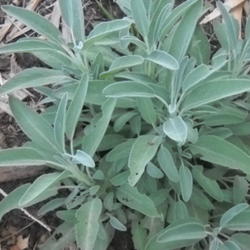
Sages encompass a large group of plants, although just a few are considered to be good culinary herbs. The most familiar of these is garden sage (Salvia officinalis), a hardy perennial characterized by its soft, gray-green foliage and spikes of light-colored spring flowers. Plants can get quite tall and floppy, but the dwarf form (Salvia officinalis var. nana) has a more compact growth habit. Its flavor equals that of the standard variety, but it is not as hardy.
Some cultivars of garden sage are as at home in the perennial border as in the kitchen garden, thanks to their stunning leaf color. Three outstanding varieties are purple sage (S.o. cv. Purpurescens), golden sage (S.o. cv. Aurea), and tricolor sage (S.o. cv. Tricolor). These tend to be less hardy than regular sage.
You can start seed indoors up to eight weeks before your last frost date. If you sow seeds right in the garden, do so up to two weeks before the last frost date. Use fresh seed, as it doesn't store well. You can also start plants from root cuttings from established plants. Set plants or thin seedlings to stand 24 to 30 inches apart. Sage thrives in full sun and well-drained soil. Young plants need a steady moisture supply until they start growing vigorously.
Each spring, prune out the woodiest stems and spent flower stalks. Stop harvesting early in the fall to encourage the plant to harden off for the winter. After a few years, plants become quite woody and less productive. Plan a year ahead to replace them.
Harvest lightly during the first year to allow this perennial plant to become established. In the following couple of years, you may be able to harvest an entire plant two or three times. When harvesting, leave a few stalks in place to allow the plant to rejuvenate.
If you wish to dry sage, hang stalks in a shady, well-ventilated area until the leaves crumble easily, then store in tightly lidded jars. Sage keeps its flavor better if stored in the freezer. Freeze leaves or stalks on a tray, then move the leaves into a zippered bag or container. Some cooks blend the leaves with oil, pack the ground mixture into ice cube trays to freeze, and then transfer the cubes to a container.
Photograph by Suzanne DeJohn/National Gardening Association
 Victory Seed Company has all the seeds you want for your best garden in 2024.
Victory Seed Company has all the seeds you want for your best garden in 2024.
For 25 years, the family-owned Victory Seed Company has provided the highest quality vegetable, herb and flower seeds to families across the country. We are passionate about providing you the best seeds available that give excellent germination, robust plants, and the harvest you want. With a catalog of over a thousand varieties, we have everything, and our prices are the kinds that we'd want to pay. We have hundreds of yesterday's heirloom vegetables, as well as today's award winning hybrid selections. Get to know us by visiting our website and browsing through our online vegetable seed catalog.
| 1. Growing Basil |
| 2. Growing Dill |
| 3. Growing Sage ← you're on this article right now |
| 4. Growing Parsley |
| 5. Basil Varieties |
| 1. Growing Basil |
| 2. Growing Dill |
| 3. Growing Sage ← you're on this article right now |
| 4. Growing Parsley |
| 5. Basil Varieties |